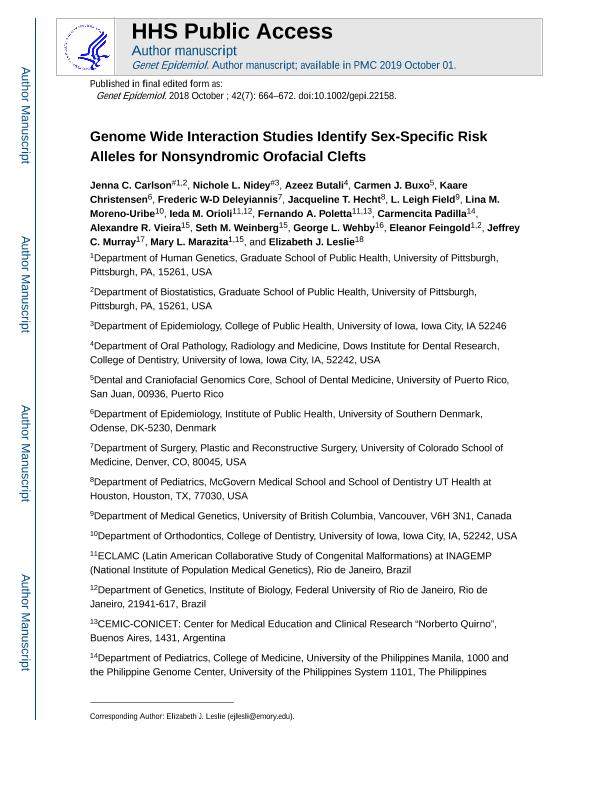Artículo
Genome-wide interaction studies identify sex-specific risk alleles for nonsyndromic orofacial clefts
Carlson, Jenna C.; Nidey, Nichole L.; Butali, Azeez; Buxo, Carmen J.; Christensen, Kaare; Deleyiannis, Frederic W. D.; Hecht, Jacqueline T.; Field, L. Leigh; Moreno Uribe, Lina M.; Orioli, Ieda Maria; Poletta, Fernando Adrián ; Padilla, Carmencita; Vieira, Alexandre R.; Weinberg, Seth M.; Wehby, George; Feingold, Sergio; Murray, Jeffrey C.; Marazita, Mary L.; Leslie, Elizabeth J.
; Padilla, Carmencita; Vieira, Alexandre R.; Weinberg, Seth M.; Wehby, George; Feingold, Sergio; Murray, Jeffrey C.; Marazita, Mary L.; Leslie, Elizabeth J.
 ; Padilla, Carmencita; Vieira, Alexandre R.; Weinberg, Seth M.; Wehby, George; Feingold, Sergio; Murray, Jeffrey C.; Marazita, Mary L.; Leslie, Elizabeth J.
; Padilla, Carmencita; Vieira, Alexandre R.; Weinberg, Seth M.; Wehby, George; Feingold, Sergio; Murray, Jeffrey C.; Marazita, Mary L.; Leslie, Elizabeth J.
Fecha de publicación:
10/2018
Editorial:
Wiley-liss, div John Wiley & Sons Inc.
Revista:
Genetic Epidemiology
ISSN:
0741-0395
Idioma:
Inglés
Tipo de recurso:
Artículo publicado
Clasificación temática:
Resumen
Nonsyndromic cleft lip with or without cleft palate (NSCL/P) is the most common craniofacial birth defect in humans and is notable for its apparent sexual dimorphism where approximately twice as many males are affected as females. The sources of this disparity are largely unknown, but interactions between genetic and sex effects are likely contributors. We examined gene-by-sex (G × S) interactions in a worldwide sample of 2,142 NSCL/P cases and 1,700 controls recruited from 13 countries. First, we performed genome-wide joint tests of the genetic (G) and G × S effects genome-wide using logistic regression assuming an additive genetic model and adjusting for 18 principal components of ancestry. We further interrogated loci with suggestive results from the joint test (p < 1.00 × 10 −5) by examining the G × S effects from the same model. Out of the 133 loci with suggestive results (p < 1.00 × 10 −5) for the joint test, we observed one genome-wide significant G × S effect in the 10q21 locus (rs72804706; p = 6.69 × 10 −9; OR = 2.62 CI [1.89, 3.62]) and 16 suggestive G × S effects. At the intergenic 10q21 locus, the risk of NSCL/P is estimated to increase with additional copies of the minor allele for females, but the opposite effect for males. Our observation that the impact of genetic variants on NSCL/P risk differs for males and females may further our understanding of the genetic architecture of NSCL/P and the sex differences underlying clefts and other birth defects.
Palabras clave:
CLEFT LIP
,
CLEFT PALATE
,
GENETIC RISK
,
ORAL FACIAL CLEFT
Archivos asociados
Licencia
Identificadores
Colecciones
Articulos(CEMIC-CONICET)
Articulos de CENTRO DE EDUCACION MEDICA E INVESTIGACIONES CLINICAS "NORBERTO QUIRNO"
Articulos de CENTRO DE EDUCACION MEDICA E INVESTIGACIONES CLINICAS "NORBERTO QUIRNO"
Citación
Carlson, Jenna C.; Nidey, Nichole L.; Butali, Azeez; Buxo, Carmen J.; Christensen, Kaare; et al.; Genome-wide interaction studies identify sex-specific risk alleles for nonsyndromic orofacial clefts; Wiley-liss, div John Wiley & Sons Inc.; Genetic Epidemiology; 42; 7; 10-2018; 664-672
Compartir
Altmétricas



